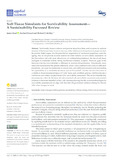- CERES Home
- →
- Cranfield Defence and Security
- →
- Staff publications (CDS)
- →
- View Item
JavaScript is disabled for your browser. Some features of this site may not work without it.
| dc.contributor.author | Read, James | |
| dc.contributor.author | Hazael, Rachael | |
| dc.contributor.author | Critchley, Richard | |
| dc.date.accessioned | 2022-05-19T14:32:23Z | |
| dc.date.available | 2022-05-19T14:32:23Z | |
| dc.date.issued | 2022-05-13 | |
| dc.identifier.citation | Read J, Hazael R, Critchley R. (2022) Soft tissue simulants for survivability assessment—a sustainability focussed review, Applied Sciences, Volume 12, Issue 10, May 2022, Article number 4954 | en_UK |
| dc.identifier.issn | 2076-3417 | |
| dc.identifier.uri | https://doi.org/10.3390/app12104954 | |
| dc.identifier.uri | http://dspace.lib.cranfield.ac.uk/handle/1826/17920 | |
| dc.description.abstract | Traditionally, human cadavers and porcine tissue have been used as means to replicate elements of the human body; however, because of the differences in biomechanical properties from the porcine limbs/organs and the potential for degradation of mechanical properties caused by ageing, they do not provide accurate material for either lethality or survivability assessment. In the 21st century and with more ethical ways of working being employed, the use of soft tissue analogues to undertake ballistic testing has become routinely accepted. However, gaps in the literature exist that have identified a difference in material characterisation. Procedurally, every researcher manufactures the gelatine differently, which, when combined with a lack of calibration procedures, can cause inconsistencies in output data, and additional concerns exist surrounding the repeatability of re-mouldable simulants, such as Perma-Gel®. Further, limited information is available on the environmental impact of ‘1 shot’ items, such as ballistic gelatine, which has become a well-known and widely accepted material for survivability assessment. This review identifies key inconsistencies within the literature, the risk associated with survivability assessment, and potential solutions to the issues identified within, with outcomes showing that the current methodologies for survivability assessment do not align with the wider UK government ambition of being Net Zero by 2050 unless changes are made. | en_UK |
| dc.description.sponsorship | This research was supported by Cranfield Forensics Institute, The Defence Ordnance Safety Group, and Defence Equipment and Support. | en_UK |
| dc.language.iso | en | en_UK |
| dc.publisher | MDPI | en_UK |
| dc.rights | Attribution 4.0 International | * |
| dc.rights.uri | http://creativecommons.org/licenses/by/4.0/ | * |
| dc.subject | tissue analogue | en_UK |
| dc.subject | ballistic gelatine | en_UK |
| dc.subject | sustainability | en_UK |
| dc.subject | ballistic testing | en_UK |
| dc.subject | Perma-Gel | en_UK |
| dc.subject | environment | en_UK |
| dc.title | Soft tissue simulants for survivability assessment—a sustainability focussed review | en_UK |
| dc.type | Article | en_UK |
Files in this item
The following license files are associated with this item:
This item appears in the following Collection(s)
-
Staff publications (CDS) [1216]

